Integrated Photonics on Glass: A Review of the Ion-Exchange Technology Achievements
Abstract
Featured Application
Abstract
1. Introduction
2. Ion-Exchanged Waveguides
2.1. Principle and Technology
2.2. Modelling Ion-Exchanged Waveguides
2.3. Waveguide’s Performances
2.3.1. Passive Glasses
2.3.2. Active Glasses
2.3.3. Exotic Substrates
3. Telecom Devices
3.1. Context and Historical Overview
3.2. Wavelength Multiplexers
3.3. Waveguide Amplifiers and Lasers
3.4. Hybrid Devices
4. Sensors
5. Conclusions
Funding
Institutional Review Board Statement
Informed Consent Statement
Conflicts of Interest
References
- Izawa, T. Optical waveguide formed by electrically induced migration of ions in glass plates. Appl. Phys. Lett. 1972, 21, 584–586. [Google Scholar] [CrossRef]
- Terai, R.; Hayami, R. Ionic diffusion in glasses. J. Non-Crystalline Solids 1975, 18, 217–264. [Google Scholar] [CrossRef]
- Findakly, T. Glass Waveguides by Ion Exchange: A Review. Opt. Eng. 1985, 24, 242244. [Google Scholar] [CrossRef]
- Ramaswamy, R.; Srivastava, R. Ion-exchanged glass waveguides: A review. J. Light. Technol. 1988, 6, 984–1000. [Google Scholar] [CrossRef]
- Ross, L. Integrated Optical Components in Substrate Glasses. Glastech. Ber. 1989, 62, 285–297. [Google Scholar]
- Nikonorov, G.T.; Petrovskii, N.V. Ion-exchanged glasses in integrated optics: The current state of research and prospects (a review). Glass Phys. Chem. 1999, 25, 16–55. [Google Scholar]
- Broquin, J.E. Glass integrated optics: State of the art and position toward other technologies. In Proceedings of the Integrated Optics: Devices, Materials, and Technologies XI, San Jose, CA, USA, 22–24 January 2007. [Google Scholar]
- Mazzoldi, P.; Sada, C. A trip in the history and evolution of ion-exchange process. Mater. Sci. Eng. B 2008, 149, 112–117. [Google Scholar] [CrossRef]
- West, B.R.; Tervonen, A.; Honkanen, S. Ion-exchanged glass waveguide technology: A review. Opt. Eng. 2011, 50, 071107. [Google Scholar] [CrossRef]
- Zachariasen, W.H. The atomic arrangement in glass. J. Am. Chem. Soc. 1932, 54, 3841–3851. [Google Scholar] [CrossRef]
- Huggins, M.L.; Sun, K.H.; Davis, D.O. The Dispersion of Silicate Glasses as a Function of Composition II*. J. Opt. Soc. Am. 1942, 32, 635–648. [Google Scholar] [CrossRef]
- Doremus, R.H. Glass Science; Wiley & Sons: New York, NY, USA, 1973. [Google Scholar]
- Lilienhof, H.J.; Voges, E.; Ritter, D.; Pantschew, B. Field-induced index profiles of multimode ion-exchanged strip waveguides. IEEE J. Quantum Electron. 1982, 18, 1877–1883. [Google Scholar] [CrossRef]
- Chartier, G.; Jaussaud, P.; De Oliveira, A.; Parriaux, O. Fast fabrication method for thick and highly multimode optical waveguides. Electron. Lett. 1977, 13, 763–764. [Google Scholar] [CrossRef]
- Viljanen, J.; Leppihalme, M. Fabrication of optical strip waveguides with nearly circular cross section by silver ion migration technique. J. Appl. Phys. 1980, 51, 3563–3565. [Google Scholar] [CrossRef]
- Pantchev, B. One-step field-assisted ion exchange for fabrication of buried multimode optical strip waveguides. Electron. Lett. 1987, 23, 1188–1190. [Google Scholar] [CrossRef]
- Seki, M.; Hashizume, H.; Sugawara, R. Two-step purely thermal ion-exchange technique for single-mode waveguide devices in glass. Electron. Lett. 1988, 24, 1258–1259. [Google Scholar] [CrossRef]
- Prieto-Blanco, X. Electro-diffusion equations of monovalent cations in glass under charge neutrality approximation for optical waveguide fabrication. Opt. Mater. 2008, 31, 418–428. [Google Scholar] [CrossRef]
- Quaranta, A.; Cattaruzza, E.; Gonella, F. Modelling the ion exchange process in glass: Phenomenological approaches and perspectives. Mater. Sci. Eng. B 2008, 149, 133–139. [Google Scholar] [CrossRef]
- Quaranta, A.; Rahman, A.; Mariotto, G.; Maurizio, C.; Trave, E.; Gonella, F.; Cattaruzza, E.; Gibaudo, E.; Broquin, J.E. Spectroscopic Investigation of Structural Rearrangements in Silver Ion-Exchanged Silicate Glasses. J. Phys. Chem. C 2012, 116, 3757–3764. [Google Scholar] [CrossRef]
- Albert, J.; Lit, J.W. Full modeling of field-assisted ion exchange for graded index buried channel optical waveguides. Appl. Opt. 1990, 29, 2798–2804. [Google Scholar] [CrossRef] [PubMed]
- Tervonen, A. A general model for fabrication processes of channel waveguides by ion exchange. J. Appl. Phys. 1990, 67, 2746–2752. [Google Scholar] [CrossRef]
- Tien, P.K.; Ulrich, R. Theory of Prism–Film Coupler and Thin-Film Light Guides. J. Opt. Soc. Am. 1970, 60, 1325–1337. [Google Scholar] [CrossRef]
- Chiang, K. Construction of refractive-index profiles of planar dielectric waveguides from the distribution of effective indexes. J. Light. Technol. 1985, 3, 385–391. [Google Scholar] [CrossRef]
- White, J.M.; Heidrich, P.F. Optical waveguide refractive index profiles determined from measurement of mode indices: A simple analysis. Appl. Opt. 1976, 15, 151–155. [Google Scholar] [CrossRef] [PubMed]
- Kirchheim, R.; Paulmann, D. The relevance of site energy distribution for the mixed alkali effect. J. Non-Cryst. Solids 2001, 286, 210–223. [Google Scholar] [CrossRef]
- Lupascu, A.; Kevorkian, A.; Boudet, T.; Saint-Andre, F.; Persegol, D.; Levy, M. Modeling ion exchange in glass with concentration-dependent diffusion coefficients and mobilities. Opt. Eng. 1996, 35, 1603–1610. [Google Scholar] [CrossRef]
- West, B.R.; Madasamy, P.; Peyghambarian, N.; Honkanen, S. Modeling of ion-exchanged glass waveguide structures. J. Non-Cryst. Solids 2004, 347, 18–26. [Google Scholar] [CrossRef]
- Hazart, J.; Minier, V. Concentration profile calculation for buried ion-exchanged channel waveguides in glass using explicit space-charge analysis. IEEE J. Quantum Electron. 2001, 37, 606–612. [Google Scholar] [CrossRef]
- Masalkar, P.J. Calculation of Concentration Profile in Ion-Exchange Waveguides by Finite Difference ADI Method. Optik 1994, 95, 168–172. [Google Scholar]
- Saarikoski, H.; Salmio, R.P.; Saarinen, J.; Eirola, T.; Tervonen, A. Fast numerical solution of nonlinear diffusion equation for the simulation of ion-exchanged micro-optics components in glass. Opt. Commun. 1997, 134, 362–370. [Google Scholar] [CrossRef]
- Fabricius, N.; Oeste, H.; Guttmann, H.; Quast, H.; Ross, L. BGG 31: A New Glass for Multimode Waveguide Fabrication. Proc. EFOC/LAN 1988, 88, 59–62. [Google Scholar]
- Araujo, R. Colorless glasses containing ion-exchanged silver. Appl. Opt. 1992, 31, 5221–5224. [Google Scholar] [CrossRef] [PubMed]
- Walker, R.G.; Wilkinson, C.D.W.; Wilkinson, J.A.H. Integrated optical waveguiding structures made by silver ion-exchange in glass 1: The propagation characteristics of stripe ion-exchanged waveguides: A theoretical and experimental investigation. Appl. Opt. 1983, 22, 1923–1928. [Google Scholar] [CrossRef] [PubMed]
- Schimpf, A.; Bucci, D.; Nannini, M.; Magnaldo, A.; Couston, L.; Broquin, J.-E. Photothermal microfluidic sensor based on an integrated Young interferometer made by ion exchange in glass. Sens. Actuators B Chem. 2012, 163, 29–37. [Google Scholar] [CrossRef]
- Onestas, L.; Bucci, D.; Ghibaudo, E.; Broquin, J.-E. Vertically Integrated Broadband Duplexer for Erbium-Doped Waveguide Amplifiers Made by Ion Exchange on Glass. IEEE Photonics Technol. Lett. 2011, 23, 648–650. [Google Scholar] [CrossRef]
- Pantchev, B.; Danesh, P. Masking Problem in the Fabrication of Optical Waveguide Structures in Glass by Double Ion Exchange. Jpn. J. Appl. Phys. 1997, 36, 4320–4322. [Google Scholar] [CrossRef]
- Glingener, B.B.C. Polarization Insensitive Ion-Exchanged Arrayed-Waveguide Grating Multiplexers in Glass. Fiber Integr. Opt. 1998, 17, 279–298. [Google Scholar] [CrossRef]
- Jamon, D.; Royer, F.; Parsy, F.; Ghibaudo, E.; Broquin, J.E. Birefringence Measurements in Optical Waveguides. J. Light. Technol. 2013, 31, 3151–3157. [Google Scholar] [CrossRef]
- Yliniemi, S.; West, B.R.; Honkanen, S. Ion-exchanged glass waveguides with low birefringence for a broad range of waveguide widths. Appl. Opt. 2005, 44, 3358–3363. [Google Scholar] [CrossRef] [PubMed][Green Version]
- Veasey, D.L.; Funk, D.S.; Sanford, N.A.; Hayden, J.S. Arrays of distributed-Bragg-reflector waveguide lasers at 1536 nm in Yb/Er codoped phosphate glass. Appl. Phys. Lett. 1999, 74, 789–791. [Google Scholar] [CrossRef]
- Barbier, D.; Delavaux, J.M.; Kevorkian, A.; Gastaldo, P.; Jouanno, J.M. Yb/Er Integrated optics amplifiers on phosphate glass in single and double pass configurations. In Proceedings of the Optical Fiber Communication Conference, San Diego, CA, USA, 26 February 1995. [Google Scholar]
- Josse, E.; Broquin, J.E.; Lebrasseur, E.; Fonteneau, G.; Rimet, R.; Jacquier, B.; Lucas, J. Rare-Earth-Doped Fluoride Waveguides; International Society for Optics and Photonics: Bellingham, WA, USA, 1997; Volume 2996, pp. 74–85. [Google Scholar]
- Grelin, J.; Bouchard, A.; Ghibaudo, E.; Broquin, J.-E. Study of Ag+/Na+ ion-exchange diffusion on germanate glasses: Realization of single-mode waveguides at the wavelength of 1.55 μm. Mater. Sci. Eng. B 2008, 149, 190–194. [Google Scholar] [CrossRef]
- Luo, T.; Jiang, S.; Conti, G.N.; Honkanen, S.; Mendes, S.; Peyghambarian, N. Ag/Sup+/-Na/Sup+/Exchanged Channel Waveguides in Germanate Glass. Electron. Lett. 1998, 34, 2239–2240. [Google Scholar] [CrossRef]
- Miller, S.E. Integrated Optics: An Introduction. Bell Syst. Tech. J. 1969, 48, 2059–2069. [Google Scholar] [CrossRef]
- Voirin, G.; Rimet, R.; Chartier, G. Performances of an Ion Exchanged Star Coupler for Multimode Optical Communications. In Optical Sciences; Springer: Berlin/Heidelberg, Germany, 1985; Volume 48, pp. 229–231. [Google Scholar]
- Teem Photonics. PIC Optical Waveguides for Si-Pho, Integration & Sensors. Available online: https://www.teemphotonics.com/integrated-photonics/platform/ (accessed on 25 April 2021).
- Hurvitz, T.; Ruschin, S.; Brooks, D.; Hurvitz, G.; Arad, E. Variable optical attenuator based on ion-exchange technology in glass. J. Light. Technol. 2005, 23, 1918–1922. [Google Scholar] [CrossRef]
- Tervonen, A.; Honkanen, S.; Najafi, S.I. Analysis of symmetric directional couplers and asymmetric Mach-Zehnder interferometers as 1.30- and 1.55-um dual-wavelength demultiplexers/multiplexers. Opt. Eng. 1993, 32, 2083–2091. [Google Scholar] [CrossRef]
- Benech, P.; Persegol, D.; Andre, F.S. A glass ion exchanged Mach-Zehnder interferometer to stabilise the frequency of a laser diode. J. Phys. D Appl. Phys. 1990, 23, 617–619. [Google Scholar] [CrossRef]
- Das, S.; Geraghty, D.F.; Peyghambarian, N. MMI splitters by ion-exchange in glass. In Proceedings of the Integrated Optics Devices IV; International Society for Optics and Photonics: Bellingham, WA, USA, 2000; Volume 3936, pp. 239–248. [Google Scholar]
- Kasprzak, D.; Błahut, M.; Maciak, E. Applications of multimode interference effects in gradient waveguides produced by ion-exchange in glass. Eur. Phys. J. Spéc. Top. 2008, 154, 113–116. [Google Scholar] [CrossRef]
- West, B.R.; Honkanen, S. MMI devices with weak guiding designed in three dimensions using a genetic algorithm. Opt. Express 2004, 12, 2716–2722. [Google Scholar] [CrossRef] [PubMed]
- West, B.R.; Plant, D.V. Optimization of non-ideal multimode interference devices. Opt. Commun. 2007, 279, 72–78. [Google Scholar] [CrossRef]
- Suhara, T.; Viljanen, J.; Leppihalme, M. Integrated-optic wavelength multi- and demultiplexers using a chirped grating and an ion-exchanged waveguide. Appl. Opt. 1982, 21, 2195–2198. [Google Scholar] [CrossRef] [PubMed]
- Ruschin, S.; Hurwitz, G.; Hurwitz, T.; Kepten, A.; Arad, E.; Soreq, Y.; Eckhouse, S. Glass ion-exchange technology for wavelength management applications. Photonics Fabr. Eur. 2003, 4944, 150–159. [Google Scholar] [CrossRef]
- Castro, J.M.; Geraghty, D.F.; West, B.R.; Honkanen, S. Fabrication and comprehensive modeling of ion-exchanged Bragg optical add-drop multiplexers. Appl. Opt. 2004, 43, 6166–6173. [Google Scholar] [CrossRef] [PubMed]
- Casale, M.; Bucci, D.; Bastard, L.; Broquin, J.-E.; Quaranta, A. Hybrid erbium-doped DFB waveguide laser made by wafer bonding of two ion-exchanged glasses. Ceram. Int. 2015, 41, 7466–7470. [Google Scholar] [CrossRef]
- Gardillou, F.; Bastard, L.; Broquin, J.E. Integrated optics Bragg filters made by ion exchange and wafer bonding. Appl. Phys. Lett. 2006, 89, 101123. [Google Scholar] [CrossRef]
- Román, J.E.; Winick, K.A. Photowritten gratings in ion-exchanged glass waveguides. Opt. Lett. 1993, 18, 808–810. [Google Scholar] [CrossRef] [PubMed]
- Montero, C.; Gomez-Reino, C.; Brebner, J.L. Planar Bragg gratings made by excimer-laser modification of ion-exchanged waveguides. Opt. Lett. 1999, 24, 1487–1489. [Google Scholar] [CrossRef] [PubMed]
- Geraghty, D.; Provenzano, D.; Marshall, W.; Honkanen, S.; Yariv, A.; Peyghambarian, N. Gratings photowritten in ion-exchanged glass channel waveguides. Electron. Lett. 1999, 35, 585. [Google Scholar] [CrossRef]
- Bucci, D.; Grelin, J.; Ghibaudo, E.; Broquin, J.-E. Realization of a 980-nm/1550-nm Pump-Signal (De)multiplexer Made by Ion-Exchange on Glass Using a Segmented Asymmetric Y-Junction. IEEE Photonics Technol. Lett. 2007, 19, 698–700. [Google Scholar] [CrossRef]
- Saruwatari, M. Nd-glass laser with three-dimensional optical waveguide. Appl. Phys. Lett. 1974, 24, 603–605. [Google Scholar] [CrossRef]
- Aoki, H.; Ishikawa, E.; Asahara, Y. Nd/Sup 3+/-Doped Glass Waveguide Amplifier at 1.054 Mu m. Electron. Lett. 1991, 27, 2351–2353. [Google Scholar] [CrossRef]
- Sanford, N.A.; Malone, K.J.; Larson, D.R.; Hickernell, R.K. Y-branch waveguide glass laser and amplifier. Opt. Lett. 1991, 16, 1168–1170. [Google Scholar] [CrossRef] [PubMed]
- Miliou, A.; Cao, X.; Srivastava, R.; Ramaswamy, R. 15-dB amplification at 1.06 mu m in ion-exchanged silicate glass waveguides. IEEE Photonics Technol. Lett. 1993, 5, 416–418. [Google Scholar] [CrossRef]
- Sanford, N.A.; Aust, J.A.; Malone, K.J.; Larson, D.R. Linewidth narrowing in an imbalanced Y-branch waveguide laser. Opt. Lett. 1993, 18, 281–283. [Google Scholar] [CrossRef] [PubMed]
- Aust, J.A.; Malone, K.J.; Veasey, D.L.; Sanford, N.A.; Roshko, A. Passively Q-switched Nd-doped waveguide laser. Opt. Lett. 1994, 19, 1849–1851. [Google Scholar] [CrossRef]
- Barbier, D.; Rattay, M.; Andre, F.S.; Clauss, G.; Trouillon, M.; Kevorkian, A.; Delavaux, J.M.; Murphy, E. Amplifying four-wavelength combiner, based on erbium/ytterbium-doped waveguide amplifiers and integrated splitters. IEEE Photonics Technol. Lett. 1997, 9, 315–317. [Google Scholar] [CrossRef]
- Reichmann, K.; Iannone, P.; Birk, M.; Frigo, N.; Barbier, D.; Cassagnettes, C.; Garret, T.; Verlucco, A.; Perrier, S.; Philipsen, J. An eight-wavelength 160-km transparent metro WDM ring network featuring cascaded erbium-doped waveguide amplifiers. IEEE Photonics Technol. Lett. 2001, 13, 1130–1132. [Google Scholar] [CrossRef]
- Patel, F.; Dicarolis, S.; Lum, P.; Venkatesh, S.; Miller, J. A Compact High-Performance Optical Waveguide Amplifier. IEEE Photonics Technol. Lett. 2004, 16, 2607–2609. [Google Scholar] [CrossRef]
- Feuchter, T.; Mwarania, E.; Wang, J.; Reekie, L.; Wilkinson, J. Erbium-doped ion-exchanged waveguide lasers in BK-7 glass. IEEE Photonics Technol. Lett. 1992, 4, 542–544. [Google Scholar] [CrossRef]
- Madasamy, P.; Conti, G.N.; Poyhonen, P.; Hu, Y.; Morrell, M.M.; Geraghty, D.F.; Honkanen, S.; Peyghambarian, N. Wave-guide Distributed Bragg Reflector Laser Arrays in Erbium Doped Glass Made by Dry Ag Film Ion Exchange. Opt. Eng. 2002, 41, 1084–1086. [Google Scholar]
- Blaize, S.; Bastard, L.; Cassagnetes, C.; Broquin, J. Multiwavelengths DFB waveguide laser arrays in Yb-Er codoped phosphate glass substrate. IEEE Photonics Technol. Lett. 2003, 15, 516–518. [Google Scholar] [CrossRef]
- Bastard, L.; Blaize, S.; Broquin, J.-E. Glass integrated optics ultranarrow linewidth distributed feedback laser matrix for dense wavelength division multiplexing applications. Opt. Eng. 2003, 42, 2800–2804. [Google Scholar] [CrossRef]
- Arab, N.; Bastard, L.; Poëtte, J.; Broquin, J.-E.; Cabon, B. Thermal coupling impact on an MMW carrier generated using two free-running DFB lasers on glass. Opt. Lett. 2018, 43, 5500–5503. [Google Scholar] [CrossRef] [PubMed]
- Yliniemi, S.; Honkanen, S.; Laronche, A.; Albert, J.; Ianoul, A. Photosensitivity and volume gratings in phosphate glasses for rare-earth-doped ion-exchanged optical waveguide lasers. J. Opt. Soc. Am. B 2006, 23, 2470–2478. [Google Scholar] [CrossRef]
- Yliniemi, S.; Albert, J.; Wang, Q.; Honkanen, S. UV-exposed Bragg gratings for laser applications in silver-sodium ion-exchanged phosphate glass waveguides. Opt. Express 2006, 14, 2898–2903. [Google Scholar] [CrossRef] [PubMed]
- Grelin, J.; Ghibaudo, E.; Broquin, J.-E. Study of deeply buried waveguides: A way towards 3D integration. Mater. Sci. Eng. B 2008, 149, 185–189. [Google Scholar] [CrossRef]
- Bertoldi, O.; Broquin, J.E.; Vitrant, G.; Collomb, V.; Trouillon, M.; Minier, V. Use of Selectively Buried Ion-Exchange Wave-guides for the Realization of Bragg Grating Filters. In Proceedings of the Integrated Optics and Photonic Integrated Circuits; International Society for Optics and Photonics: Bellingham, WA, USA, 2004; Volume 5451, pp. 182–190. [Google Scholar]
- Gardillou, F.; Bastard, L.; Broquin, J.-E. 4.25 dB gain in a hybrid silicate/phosphate glasses optical amplifier made by wafer bonding and ion-exchange techniques. Appl. Phys. Lett. 2004, 85, 5176. [Google Scholar] [CrossRef]
- Salas-Montiel, R.; Bastard, L.; Grosa, G.; Broquin, J.-E. Hybrid Neodymium-doped passively Q-switched waveguide laser. Mater. Sci. Eng. B 2008, 149, 181–184. [Google Scholar] [CrossRef]
- Ouslimani, H.; Bastard, L.; Broquin, J.-E. Narrow-linewidth Q-switched DBR laser on Ytterbium-doped glass. Ceram. Int. 2015, 41, 8650–8654. [Google Scholar] [CrossRef]
- Charlet, B.; Bastard, L.; Broquin, J.E. 1 kW peak power passively Q-switched Nd(3+)-doped glass integrated waveguide laser. Opt. Lett. 2011, 36, 1987–1989. [Google Scholar] [CrossRef]
- Charlet, B.; Bastard, L.; Broquin, J.E.; Bucci, D.; Ghibaudo, E. Supercontinuum Source Based on Ion-Exchanged Neodymium Doped Q-Switched Laser. In Proceedings of the European Conference on Integrated Optics, Sitges, Spain, 18–20 April 2012. [Google Scholar]
- Legrand, L.; Bouchard, A.; Grosa, G.; Broquin, J.E. Hybrid integration of 300nm-thick LiNbO3 films on ion-exchanged glass waveguides for efficient nonlinear integrated devices. In Proceedings of the Integrated Optics: Devices, Materials, and Technologies XXII; International Society for Optics and Photonics: Bellingham, WA, USA, 2018; Volume 10535, p. 105350E. [Google Scholar]
- Macdonald, R.I.; Lam, D.K.W.; Syrett, B.A. Hybrid optoelectronic integrated circuit. Appl. Opt. 1987, 26, 842–844. [Google Scholar] [CrossRef] [PubMed]
- Larson, D.R.; Phelan, R.J., Jr. Fast Optical Detector Deposited on Dielectric Channel Waveguides. Opt. Eng. 1988, 27, 276503. [Google Scholar] [CrossRef]
- Larson, D.R.; Phelan, R.J. Hydrogenated amorphous germanium detectors deposited onto channel waveguides. Opt. Lett. 1990, 15, 544–546. [Google Scholar] [CrossRef] [PubMed]
- Yi-Yan, A.; Chan, W.K.; Gmitter, T.J.; Florez, L.T.; Jackel, J.L.; Yablonovitch, E.; Bhat, R.; Harbison, J.P. Grafted GaAs De-tectors on Lithium Niobate and Glass Optical Waveguides. In Proceedings of the 5th European Conference on Integrated Optics: ECIO’89; International Society for Optics and Photonics: Bellingham, WA, USA, 1989; Volume 1141, pp. 154–159. [Google Scholar]
- Le Coarer, E.; Blaize, S.; Benech, P.; Stefanon, I.; Morand, A.; Lérondel, G.; Leblond, G.; Kern, P.; Fédéli, J.M.; Royer, P. Wavelength-scale stationary-wave integrated Fourier-transform spectrometry. Nat. Photonics 2007, 1, 473–478. [Google Scholar] [CrossRef]
- Thomas, F.; De Mengin, M.; Duchemin, C.; Le Coarer, E.; Bonneville, C.; Gonthiez, T.; Morand, A.; Benech, P.; Dherbecourt, J.B.; Hardy, E.; et al. High-performance high-speed spectrum analysis of laser sources with SWIFTS technology. In Proceedings of the Photonic Instrumentation Engineering; International Society for Optics and Photonics: Bellingham, WA, USA, 2014; Volume 8992, p. 89920I. [Google Scholar]
- Arnaud, L.; Bruyant, A.; Renault, M.; Hadjar, Y.; Salas-Montiel, R.; Apuzzo, A.; Lérondel, G.; Morand, A.; Benech, P.; Le Coarer, E.; et al. Waveguide-coupled nanowire as an optical antenna. J. Opt. Soc. Am. A 2013, 30, 2347–2355. [Google Scholar] [CrossRef] [PubMed]
- High-Resolution High-Rate Laser Spectrum Analyzer. Available online: https://resolutionspectra.com/products/zoom-spectra/ (accessed on 25 April 2021).
- Hellesø, O.G.; Benech, P.; Rimet, R. Interferometric displacement sensor made by integrated optics on glass. Sens. Actuators A Phys. 1995, 47, 478–481. [Google Scholar] [CrossRef]
- Lang, T.; Genon-Catalot, D.; Dandrea, P.; Duport, I.S.; Benech, P. Integrated optical displacement sensor with four quadrature phase-shifted output signals. J. Opt. 1998, 29, 135–140. [Google Scholar] [CrossRef]
- Bastard, L.; Broquin, J.-E.; Gardillou, F.; Cassagnettes, C.; Schlotterbeck, J.P.; Rondeau, P. Development of a ion-exchanged glass integrated optics DFB laser for a LIDAR application. In Proceedings of the Integrated Optics: Devices, Materials, and Technologies XIII, San Jose, CA, USA, 26–28 January 2009; International Society for Optics and Photonics: Bellingham, WA, USA, 2009; Volume 7218, p. 721817. [Google Scholar]
- Verbeek, M.J.; Jentink, H.W. Optical Air Data System Flight Testing; NLR: Amsterdam, The Netherlands, 2012. [Google Scholar]
- Haguenauer, P.; Berger, J.-P.; Rousselet-Perraut, K.; Kern, P.; Malbet, F.; Schanen-Duport, I.; Benech, P. Integrated Optics for Astronomical Interferometry. III. Optical Validation of a Planar Optics Two-Telescope Beam Combiner. Appl. Opt. 2000, 39, 2130–2139. [Google Scholar] [CrossRef] [PubMed]
- Berger, J.; Haguenauer, P.; Kern, P.; Perraut, K.; Malbet, F.; Schanen, I.; Severi, M.; Millan-Gabet, R.; Traub, W. Integrated Optics for Astronomical Interferometry-IV. First Measurements of Stars. Astron. Astrophys. 2001, 376, L31–L34. [Google Scholar] [CrossRef]
- Olivier, S.; Delage, L.; Reynaud, F.; Collomb, V.; Trouillon, M.; Grelin, J.; Schanen, I.; Minier, V.; Broquin, J.E.; Ruilier, C.; et al. MAFL experiment: Development of photonic devices for a space-based multiaperture fiber-linked interferometer. Appl. Opt. 2007, 46, 834–844. [Google Scholar] [CrossRef]
- Allenet, T.; Geoffray, F.; Bucci, D.; Canto, F.; Moisy, P.; Broquin, J.E. Microsensing of plutonium with a glass optofluidic device. Opt. Eng. 2019, 58, 060502. [Google Scholar] [CrossRef]
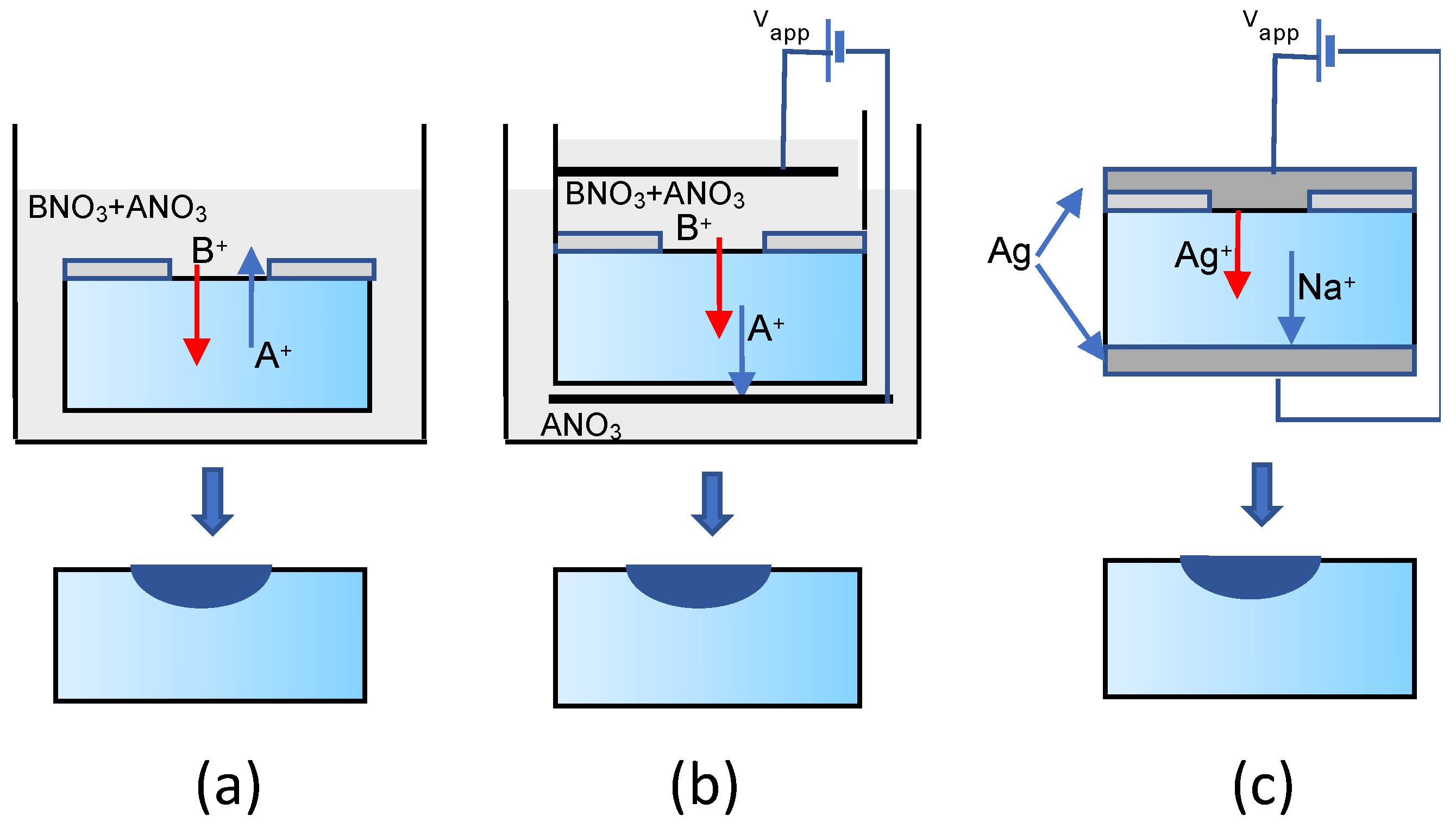
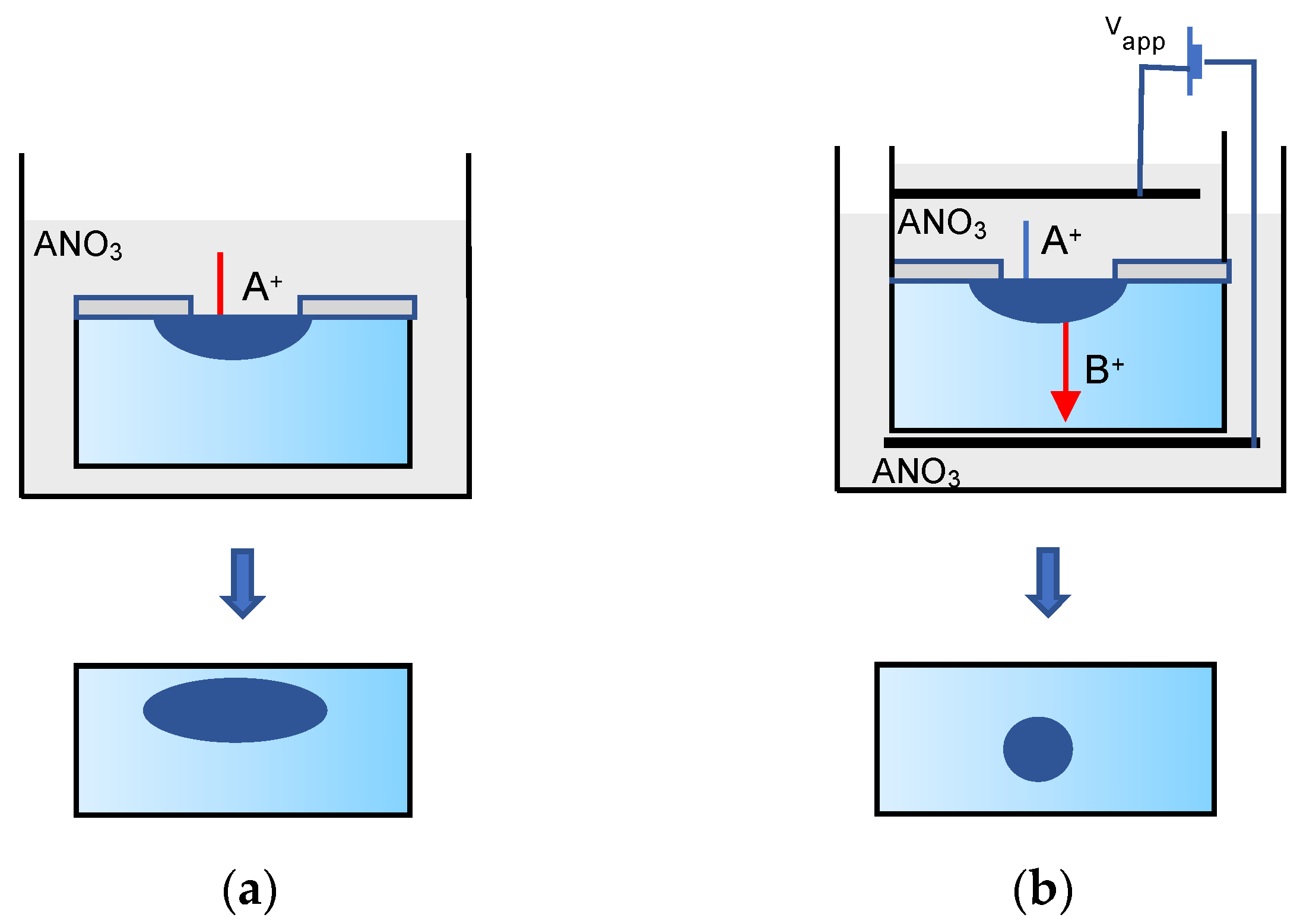
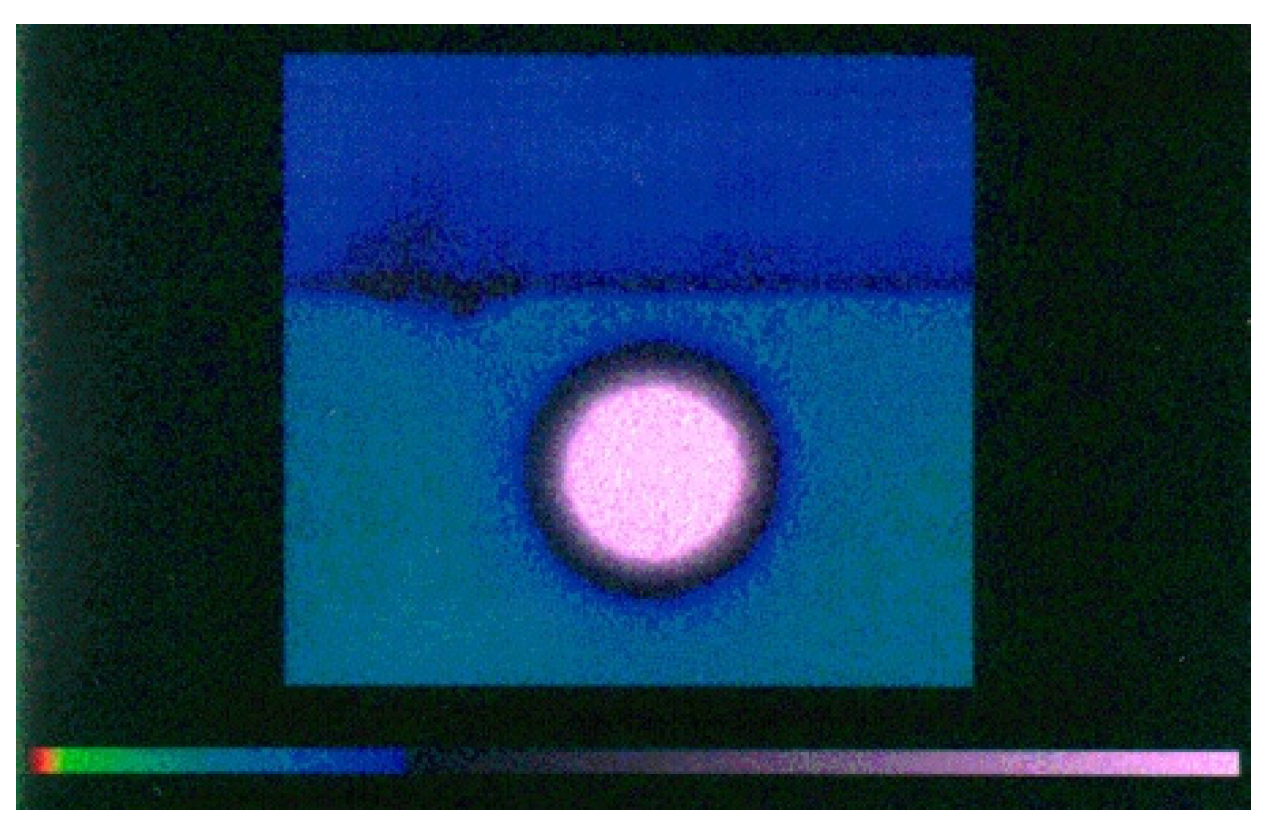

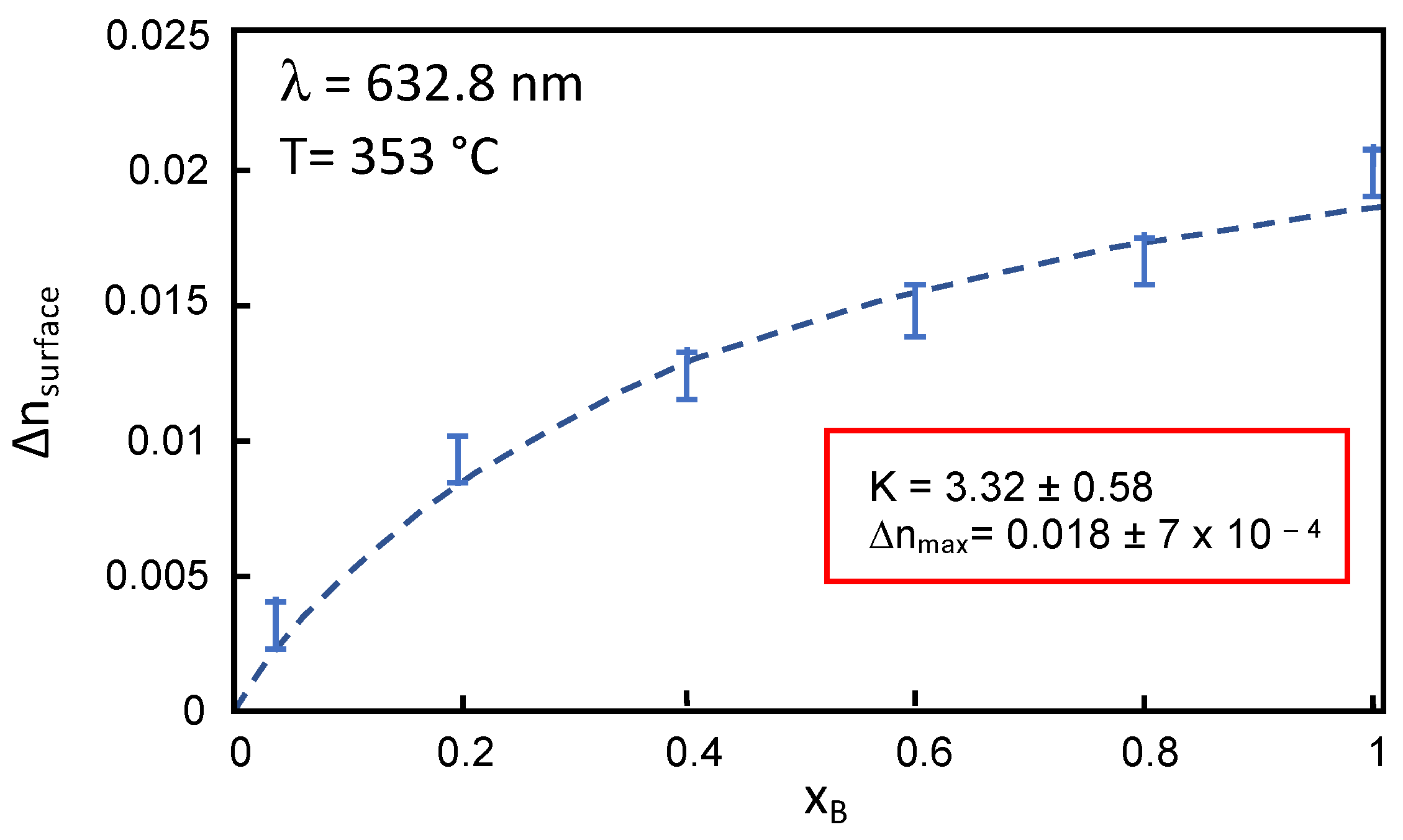
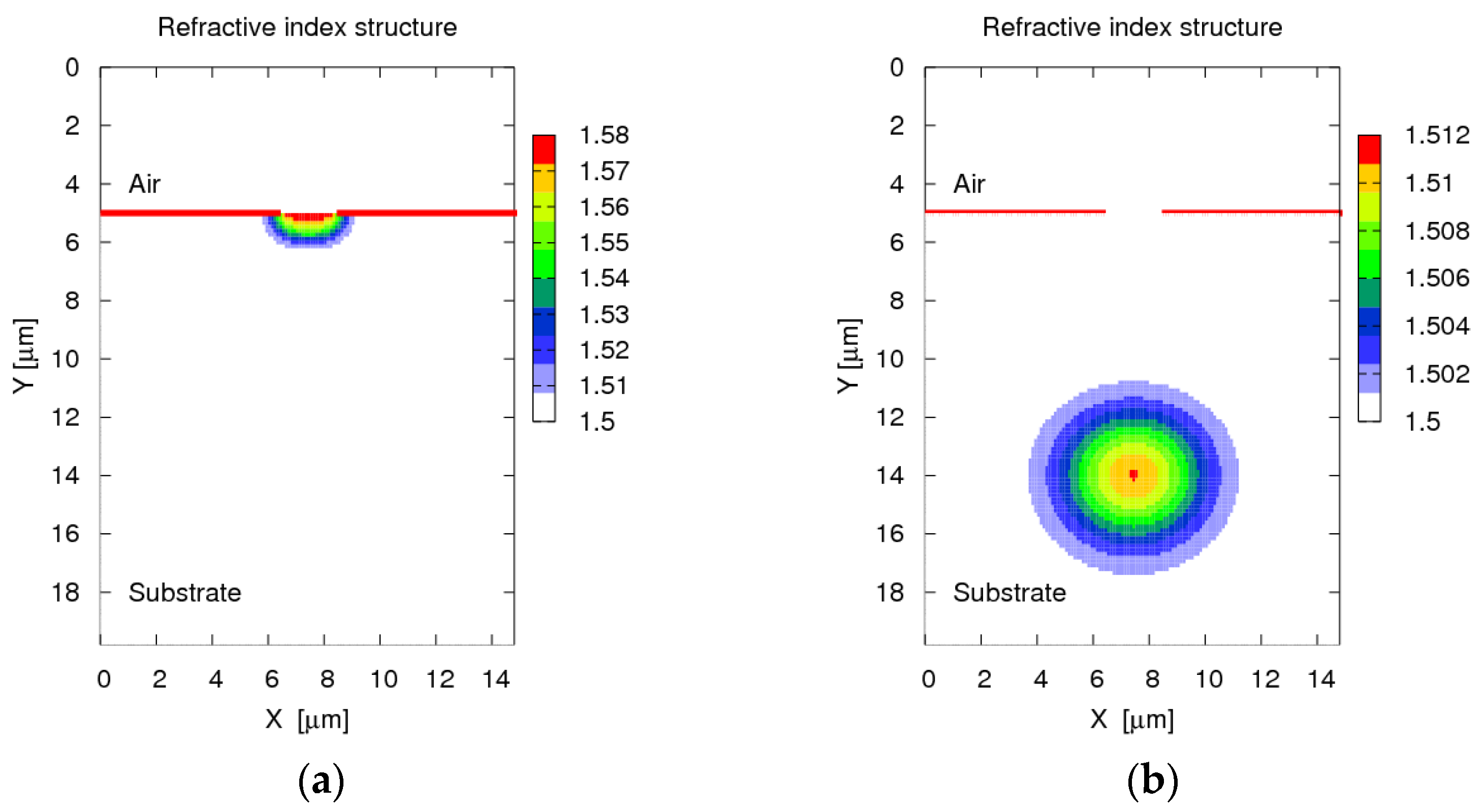
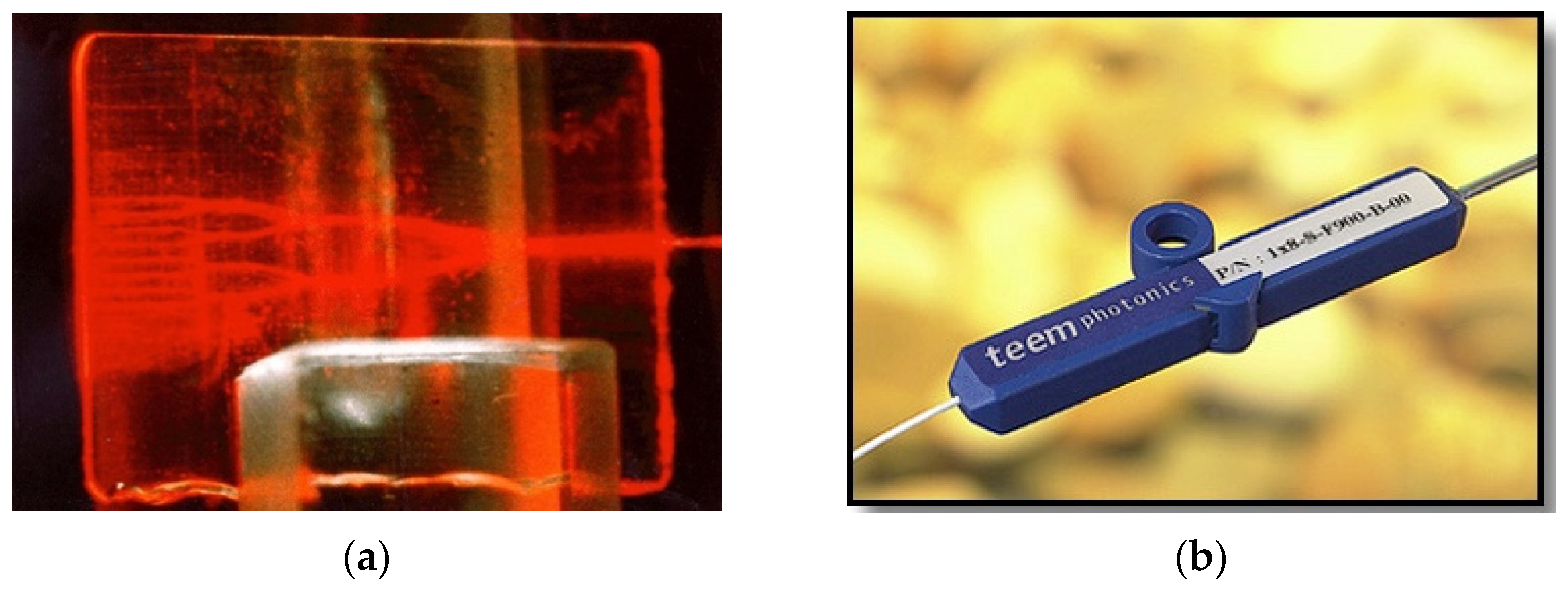
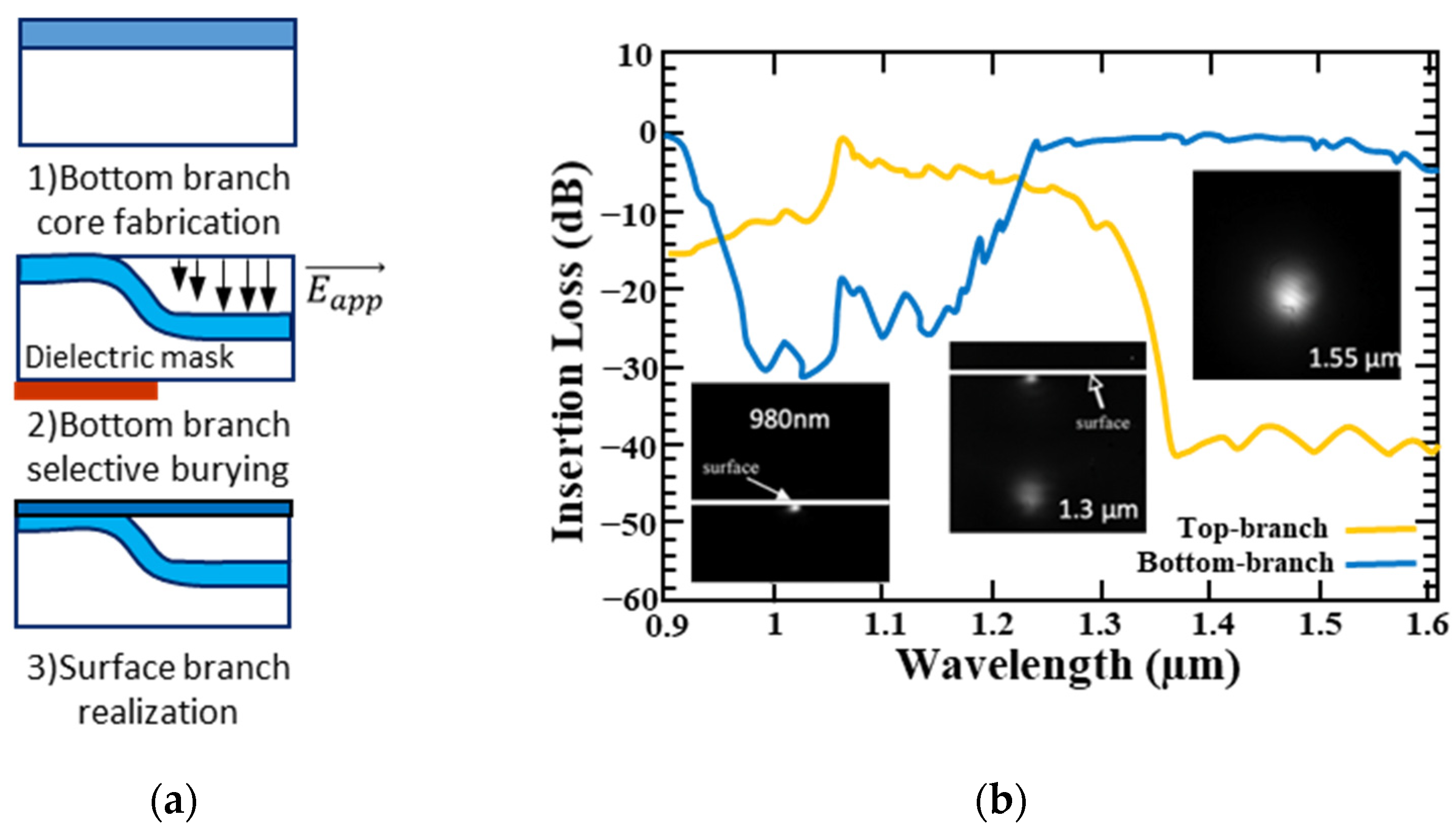


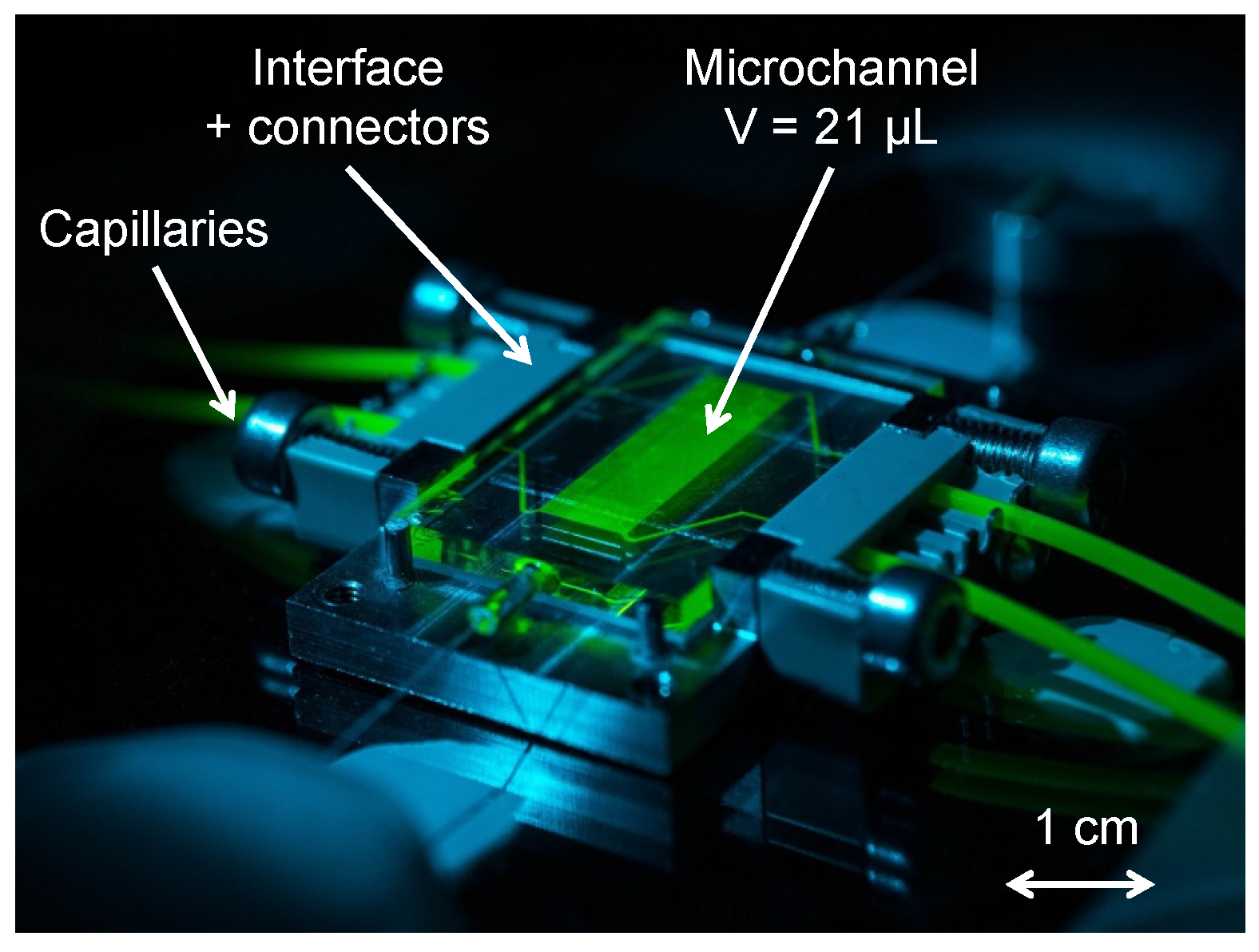
| Glass Type | GO14 | BGG31 | BF33 |
|---|---|---|---|
| Losses | <0.05 dB/cm [7] | <0.1 dB/cm | <1 dB/cm (@780 nm) |
| ∆n max | 8 × 10−2 [7] | 3.2 × 10−2 [38] | 1.8 × 10−2 [35] |
| Birefringence | <5 × 10−4 [39] | <2 × 10−5 [40] | N.A. |
| Burying depth | ~10 µm (50 µm max) | ~10 µm [38] | ~5 µm [35] |
Publisher’s Note: MDPI stays neutral with regard to jurisdictional claims in published maps and institutional affiliations. |
© 2021 by the authors. Licensee MDPI, Basel, Switzerland. This article is an open access article distributed under the terms and conditions of the Creative Commons Attribution (CC BY) license (https://creativecommons.org/licenses/by/4.0/).
Share and Cite
Broquin, J.-E.; Honkanen, S. Integrated Photonics on Glass: A Review of the Ion-Exchange Technology Achievements. Appl. Sci. 2021, 11, 4472. https://doi.org/10.3390/app11104472
Broquin J-E, Honkanen S. Integrated Photonics on Glass: A Review of the Ion-Exchange Technology Achievements. Applied Sciences. 2021; 11(10):4472. https://doi.org/10.3390/app11104472
Chicago/Turabian StyleBroquin, Jean-Emmanuel, and Seppo Honkanen. 2021. "Integrated Photonics on Glass: A Review of the Ion-Exchange Technology Achievements" Applied Sciences 11, no. 10: 4472. https://doi.org/10.3390/app11104472
APA StyleBroquin, J.-E., & Honkanen, S. (2021). Integrated Photonics on Glass: A Review of the Ion-Exchange Technology Achievements. Applied Sciences, 11(10), 4472. https://doi.org/10.3390/app11104472





